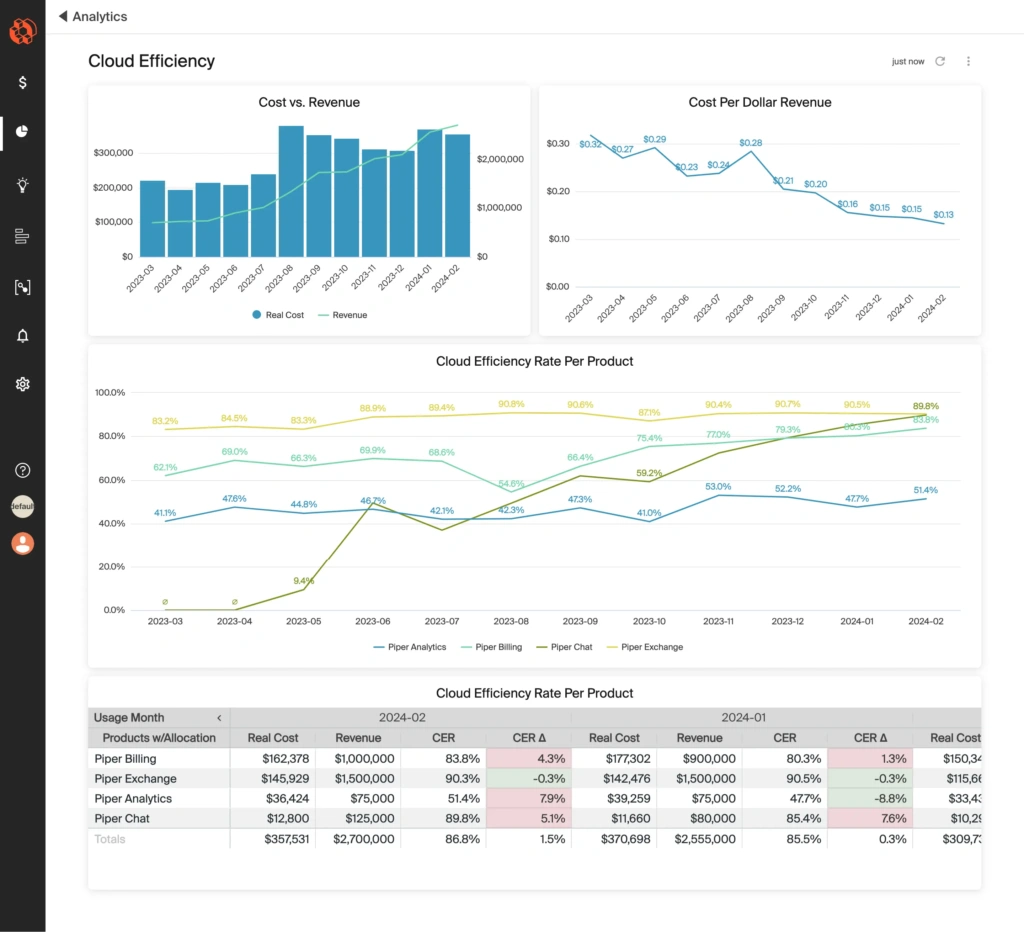Cloud and AI spending is exploding, and every dollar counts. As companies race to innovate, they also face growing pressure to prove that their cloud investments are delivering real business value.
That’s why CloudZero pioneered the Cloud Efficiency Rate (CER) metric, a unifying metric for quantifying cloud business value.
In this blog, we’ll walk you through CER in its simplest and most advanced forms, go over benchmarks for low, average, and elite CER, and demonstrate the role CER plays in business optimization.
How Is Cloud Efficiency Rate (CER) Calculated?
Here’s the simple formula for CER:
(Revenue – Cloud Costs) / Revenue = CER
So, for a company (Company A) with $100M of revenue and $8M of cloud costs, their CER would be:
($100M – $8M) / $100M = .92, or 92%
A CER of 92% or higher happens to be an elite CER (more on percentiles below).
CER Vs. COGS, R&D OpEx, And Gross Margin
CER stands apart from traditional SaaS metrics like COGS, R&D OpEx, and gross margin in a few key ways:
- It excludes headcount and other fixed OpEx that finance teams care about, making it more actionable for engineering and product teams focused on infrastructure efficiency
- It includes all cloud and AI spend across both R&D and production, giving you a complete view of your variable cloud costs
By isolating just the cloud portion of your operating expenses and mapping it directly to revenue, CER helps you answer a critical question: When we spend a dollar in the cloud, how much do we get back?
CER Per Dimension
CER becomes especially useful when you break it down by specific business dimensions, like product, customer, team, feature, and so on. Determining your most and least efficient customers can help you refine customer contracts and your ideal customer profile. Identifying your most and least efficient products can help you refine your pricing and packaging strategy. Watching CER trends for any business dimension shows you how efficiently that dimension is scaling.
Ex. 1: Customer Inefficiency
Let’s say Company A, the one with $8M in cloud costs, $100M in revenue, and a 92% CER, has three customers. Here’s how their cloud costs and revenue break down per customer:
| Customer | Cloud Costs | Revenue | CER |
| Peter | $5M | $40M | 87.5% |
| Paul | $1M | $35M | 97.1% |
| Mary | $2M | $25M | 92% |
Peter is Company A’s most revenue-producing customer — and their least efficient. Knowing this will prompt an investigation into the underlying reasons for Peter’s relative inefficiency. Depending on what they find, this investigation could prompt an array of strategic business decisions:
- Restructure Peter’s contract
- Refactor the infrastructure supporting Peter (perhaps drawing inspiration from Paul’s elite-plus efficiency)
- Further break down Peter’s CER by the products and features he’s using
Company A will get the most value out of CER by assessing it not just per customer, but per product per customer.
(It bears noting that some business leaders may say Peter brings in the most revenue even after cloud costs — while that remains true, focusing on efficiency is still crucial.)
Multidimensional CER
| Customer | Revenue | Cloud Costs (PRODUCT 1) | Cloud Costs (PRODUCT 2) | CER (PRODUCT 1) | CER (PRODUCT 2) |
| Peter | $40M | $1.2M | $3.8M | 97% | 90.5% |
| Paul | $35M | $250K | $750K | 99% | 97.9% |
| Mary | $25M | $500 | $1.5M | 98% | 94% |
Another clear trend: Product 1 is substantially more cloud efficient than Product 2. Again, this trend will prompt an investigation into why that might be, and solutions for boosting its efficiency.
Still, Company A’s 92% CER is quite high. But how high exactly? What makes a good CER?
Low, Average, And Elite CER
CloudZero has done extensive research on CER. After combining (anonymized) internal data and data from external polls, here’s what we find makes an elite, average, and low CER:
| Elite (75th percentile and above) | Average (25th–75th percentile) | Low (25th percentile and below) |
| 92%+ | 80% | 70% |
If you want to benchmark your CER against companies like yours, you can use our free tool here.
CloudZero Is The Only Platform To Both Calculate And Optimize CER
CloudZero is purpose-built to calculate and improve CER, from allocating every dollar accurately to helping engineers act on what they see. CER’s ultimate purpose is to drive greater profitability.
Here’s a sample CloudZero cloud profitability dashboard encompassing all of the above:

Our objective when building CloudZero was to make it the most powerful, intuitive way to understand what was driving your cloud spend, and whether it was justified.
So, we developed an extremely efficient method of allocating your costs: Ingest 100% of your costs with AnyCost™, normalize all costs in a common data model, use CostFormation® to overcome allocation issues, add business context by ingesting telemetry streams, and provide a holistic, actionable view of your cloud and AI efficiency.
Perfect allocation data is the only way to get perfect CER calculations.
If you have any omissions in your spend data — because of bad tagging, because of shared costs, because of containerized costs (none of which CloudZero struggles with) — your CER will be inaccurate, and you’ll misrepresent your business value to customers, investors, acquirers, market regulators, and whoever else might be interested.
Furthermore, CloudZero is the only platform to optimize your CER, through a process that puts engineers at the center of cost savings.
Precise, granular, layerable CER shows you where you need to direct your savings energy; features like Insights, Anomalies, and Explorer point your engineers directly at inefficient cloud infrastructure and resources.
Don’t settle for vague estimates of your cloud ROI. Get the precision and context your teams need to optimize what matters, and drive better business outcomes.
Cloud Efficiency Rate (CER) FAQs
What is Cloud Efficiency Rate (CER)?
Cloud Efficiency Rate (CER) is a financial metric that measures how efficiently a company converts cloud and AI spending into revenue. It shows the percentage of revenue that remains after cloud costs are removed, making cloud business value explicit and quantifiable.
How do you calculate Cloud Efficiency Rate (CER)?
Cloud Efficiency Rate (CER) is calculated using this formula:
(Revenue – Cloud Costs) ÷ Revenue = CER
For example, if a company earns $100 million in revenue and spends $8 million on cloud infrastructure, its CER is 92%. This means 92% of revenue remains after cloud costs.
What is considered a good Cloud Efficiency Rate (CER)?
A good Cloud Efficiency Rate depends on benchmarking, but CloudZero research shows clear ranges:
- Elite CER: 92% or higher (75th percentile and above)
- Average CER: Around 80%
- Low CER: 70% or lower (25th percentile and below)
Higher CER values indicate stronger cloud efficiency and better cloud-driven business value.
How is Cloud Efficiency Rate different from gross margin or COGS?
Cloud Efficiency Rate differs from gross margin and COGS because it isolates only cloud and AI costs, excluding headcount and fixed operating expenses. CER is designed to be actionable for engineering and product teams by directly linking cloud spend to revenue, rather than blending it into broader financial metrics.
How can companies improve their Cloud Efficiency Rate (CER)?
Companies improve Cloud Efficiency Rate by accurately allocating all cloud costs, analyzing CER by dimensions like customer, product, and feature, and directing engineers toward inefficient infrastructure. Platforms like CloudZero enable this by providing precise cost allocation, multidimensional CER analysis, and engineering-focused optimization tools.








